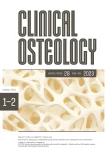Sterilní zánět po radiofrekvenční ablaci osteoidního osteomu
Autoři:
Butarbutar Christian Parsaoran John 1; Putra Widhia Laksamana Made 1; Elson 1; Suginawan Tasya Earlene 1; Mandagi Tommy 2; Partogi Samuel Alexander 3; Muljadi Rusli 4
Působiště autorů:
Department of Orthopedics and Traumatology, Faculty of Medicine, Universitas Pelita Harapan, Siloam Hospitals Lippo Village, Tangerang, Indonesia
1; Department of Orthopedics and Traumatology, Faculty of Medicine, Universitas Sumatera Utara, Medan, Sumatra Utara, Indonesia
2; Department of Anesthesiology, Faculty of Medicine, Universitas Pelita Harapan, Siloam Hospitals Lippo Village, Tangerang, Indonesia
3; Department of Radiology, Faculty of Medicine, Universitas Pelita Harapan, Siloam Hospitals Lippo Village, Tangerang, Indonesia
4
Vyšlo v časopise:
Clinical Osteology 2023; 28(1-2): 34-38
Kategorie:
Kazuistiky
Souhrn
Introduction: Osteoid osteoma is a benign bone tumor with the classical characteristic of pain that subsides significantly with the use of nonsteroidal anti-inflammatory drugs. When conservative therapy fails, a surgical approach is then recommended. Radiofrequency ablation (RFA) has become more widely used compared to open resection due to fewer serious postoperative complications. But it is still important that the complications of RFA be recognized and addressed. Case report: We present a case of a 22-year-old man with acute pain on his left shin, accompanied by signs of localized inflammation. The clinical findings and radiology support the diagnosis of osteoid osteoma. A surgical intervention with percutaneous radiofrequency ablation was performed. However, post-operatively, the patient complains of prolonged fluid discharge from the surgical site. Following the biopsy and debridement surgery, both specimen culture and histopathology results revealed sterile inflammation with no specific process. Conclusion: RFA has become the most popular treatment of choice for osteoid osteoma, but it still comes with complications, most commonly involving subcutaneous bones such as the tibia. In conclusion, extra caution is needed when treating subcutaneously located bones with RFA.
Zdroje
1. Oc Y, Kilinc BE, Cennet S et al. Complications of Computer Tomography Assisted Radiofrequency Ablation in the Treatment of Osteoid Osteoma. Biomed Res Int 2019; 2019: 4376851. Dostupné z DOI: <http://dx.doi.org/10.1155/2019/4376851>.
2. Cąkar M, Esenyel CZ, Seyran M et al. Osteoid Osteoma Treated with Radiofrequency A blation. Adv Orthop 2 015; 2 015: 8 07274. Dostupné z DOI: <http://dx.doi.org/10.1155/2015/807274>.
3. Moberg E. The natural course of osteoid osteoma. J Bone Joint Surg Am 1951; 33 A(1): 166–170.
4. Golding JS. The Natural History of Osteoid Osteoma; with a report of t wenty c ases. J Bone Joint Surg Br 1954; 3 6-B(2): 218–229. Dostupné z DOI: <http://dx.doi.org/10.1302/0301–620X.36B2.218>.
5. Noordin S, Allana S, Hilal K et al. Osteoid osteoma: Contemporary management. Orthop Rev (Pavia) 2018; 10(3): 7496. Dostupné z DOI: <http://dx.doi.org/10.4081/or.2018.7496>.
6. Motamedi K, Katz MD, Earl W et al. Thermal Ablation of Osteoid Osteoma : Overview and step-by-step guide. Radiographic 2009; 29(7): 2127–2141. Dostupné z DOI: <http://dx.doi.org/10.1148/rg.297095081>.
7. Rosenthal DI, Hornicek FJ, Wolfe MW et al. Percutaneous radiofrequency coagulation of osteoid osteoma compared with operative treatment. J Bone Joint Surg Am 1998; 80(6): 815–821. Dostupné z DOI: <http://dx.doi.org/10.2106/00004623–199806000–00005>.
8. Greco F, Tamburrelli F, Ciabattoni G. Prostaglandins in osteoid osteoma. Int Orthop 1991; 15(1): 35–37. Dostupné z DOI: <http://dx.doi.org/10.1007/BF00210531>.
9. Cantwell CP, O’Byrne J, Eustace S. Radiofrequency ablation of osteoid osteoma with cooled probes and impedance-control energy delivery. Am J Roentgenol. 2006; 186(5 Suppl): S244-S248. Dostupnéz DOI: <http://dx.doi.org/10.2214/AJR.04.0938>.
10. Finstein JL, Hosalkar HS, Ogilvie CM et al. Case reports: an unusual complication of radiofrequency ablation treatment of osteoid osteoma. Clin Orthop Relat Res 2006; 448(448): 248–251. Dostupné z DOI: <http://dx.doi.org/10.1097/01.blo.0000214412.98840.a1>.
11. Lyon C, Buckwalter J. Case report: full-thickness skin necrosis after percutaneous radio-frequency ablation of a tibial osteoid osteoma. Iowa Orthop J 2008; 28: 85–87.
12. Pinto CH, Taminiau AHM, Vanderschueren GM et al. Perspective. Technical considerations in CT-guided radiofrequency thermal ablation of osteoid osteoma: Tricks of the trade. Am J Roentgenol 2002; 179(6): 1633–1642. Dostupné z DOI: <http://dx.doi.org/10.2214/ajr.179.6.1791633>.
Štítky
Biochemie Dětská gynekologie Dětská radiologie Dětská revmatologie Endokrinologie Gynekologie a porodnictví Interní lékařství Ortopedie Praktické lékařství pro dospělé Radiodiagnostika Rehabilitační a fyzikální medicína Revmatologie Traumatologie OsteologieČlánek vyšel v časopise
Clinical Osteology

2023 Číslo 1-2
- MINISERIÁL: Když ženám stoupá tlak...
- Tirzepatid – nová éra v léčbě nadváhy a obezity
- Není statin jako statin aneb praktický přehled rozdílů jednotlivých molekul
Nejčtenější v tomto čísle
- Exostóza proximálneho femuru – benígny nádor, „malígna“ lokalita: kazuistika
- Osteoporóza počas gravidity
- Zamyšlení nad příčinami senilní osteoporózy
- Jak a čím žije česká klinická osteologie v dnešní době
